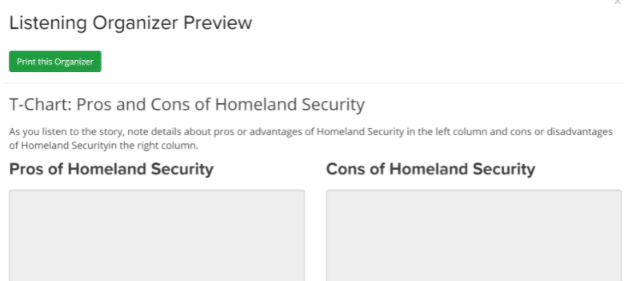Last Updated on September 28, 2022
We hosted an EdWeb webinar to share how educators can teach listening skills to promote literacy, including five research-based listening skills exercises that work for all students.
Some of the practices are especially effective for English learners and students with learning differences. You can read our five listening skills exercises below, or click here to watch the webinar.
1. Pre-teaching vocabulary
Pre-teaching vocabulary is critical because it demystifies and familiarizes students with what will happen in a lesson. Research suggests that teachers should prioritize Tier 2 general academic and cross-disciplinary vocabulary words. When students are able to recognize and use words like “classify,” “layers,” or “emerge,” they can think deeply and speak clearly about the content they are learning.
Teachers can use Listenwise’s 30- second Weird News stories to pre-teach Tier 2 vocabulary words through engaging texts. Weird News stories are current event podcasts about unusual occurrences. These stories include academic vocabulary words featured in the text. Those words are incorporated into the story’s accompanying comprehension and discussion questions. Teachers can focus on one or more of these featured words as appropriate for their particular students. We have found that this approach works especially well for elementary students and English learners.
To learn more about using Weird News to pre-teach and highlight academic vocabulary, we suggest educators check our blog post featuring Listenwise user Abby Osborn, a K-4 English Language Development teacher, who has created a structured-retelling routine using Weird News in her classroom.
2. Activating prior knowledge and building background knowledge
Activating prior knowledge and building background knowledge are key to literacy and listening comprehension. Preparing students to understand and integrate new information can happen in many ways. Teachers link concepts to student’s individual backgrounds, connect new learning to past learning, and/or provide context to fill in knowledge gaps that students may have.
All of Listenwise’s standards-aligned lessons include “Before Listening” activities in the teacher’s guide as a resource to help teachers activate prior knowledge and build background knowledge. These listening skills exercises include questions questions to elicit what students know, as well as pictures of important people, places, or events from the audio story.
In this clip from the webinar, Laura Krenicki describes how she uses an anticipation guide graphic organizer before her students listen to a story on The Black Panther Movie to activate their prior knowledge and potential biases at the start of a geography unit on sub-Saharan Africa.
3. Teaching language and content together
Listening is an excellent way for students to build content knowledge as well as learning academic vocabulary. Additionally, it has been shown to increase motivation and engagement when language is connected to meaningful content. According to World-Class Instructional Design and Assessment (WIDA) frameworks:
“Multilingual learners develop content and language concurrently, with academic content as a context for language learning and language as a means for learning academic content.”
We encourage teachers to guide students in considering the purpose of language while listening to a content-focused story. The listening organizers included with standards-aligned-lessons help students focus on language in this way. In the EdWeb webinar, Krenicki references the lesson Homeland Security: Born out of 9/11. A T-chart listening organizer for this lesson requires students to sort language for the purpose of an argument about the pros and cons of the topic.

4. Scaffolding instruction for listening
Using scaffolds helps students make sense of what they are learning. Scaffolds are flexible, so teachers can add more or remove them when necessary. Particular scaffolds may work better before, during, or after listening. Furthermore, they can also be used for whole-class, small groups, or individual student learning. A helpful instructional scaffolding strategy that teachers can use with Listenwise stories is a think-aloud. This exercise asks teachers to share with students what they are thinking as they listen, including noting language features like idioms.
Listenwise includes scaffolds within the platform that can be used as listening skills exercises. Teachers can suggest students use the interactive transcript, the slowed-audio feature, and the texthelp toolbar. Teachers can also use Lexile listening measure filtering in choosing stories that match their students’ skills and needs.
5. Encouraging speaking practice and deepening comprehension
Listening helps to foster academic conversations. Speaking during a conversation requires many skills associated with listening well. Focusing on what is being said, nodding and verbal recognition, asking good questions, and building upon what others say are all important skills to learn.
There are many ways for teachers to incorporate planned speaking practice. Teachers can use Listenwise’s comprehension questions to give students quick opportunities to turn-and-talk to other students about what they have heard. Discussion themes provide topics for lengthier conversations that engage students in making connections and engage in critical thinking.
In this clip from the EdWeb webinar Krenicki explains a speaking practice routine that teachers can use to spark discussion with Listenwise’s Friday debate stories. By the end of the routine, students have spoken to their peers for multiple purposes and practiced speaking persuasively to their teacher.
